This article explains how to install Moodle with Nginx on Ubuntu 24.04.
Installing Moodle with Nginx support on Ubuntu can offer improved performance and scalability, surpassing what Apache can provide. Nginx’s reputation for low memory usage and high concurrency makes it an excellent choice for serving web content, including Moodle.
But Nginx’s real value lies in its ability to handle many simultaneous connections, a feature that can greatly benefit Moodle’s use in educational institutions. Using Nginx as the web server for Moodle on Ubuntu ensures a smooth and highly responsive user experience.
The steps below walk you through installing Moodle with Nginx support on Ubuntu 24.04.
Install Nginx HTTP server on Ubuntu Linux
Moodle requires a web server. For this post, we will install and use the Nginx web server to run Moodle.
To do that, open the Ubuntu terminal and run the commands below to install the Nginx web server.
sudo apt update
sudo apt install nginx
Once Nginx is installed, the commands below can start, stop, and enable the Nginx web server to start automatically when your server boots up.
sudo systemctl stop nginx
sudo systemctl start nginx
sudo systemctl enable nginx
You test that the Nginx web server is running by opening your web browser and browsing to the server’s localhost or IP address.
http://localhost
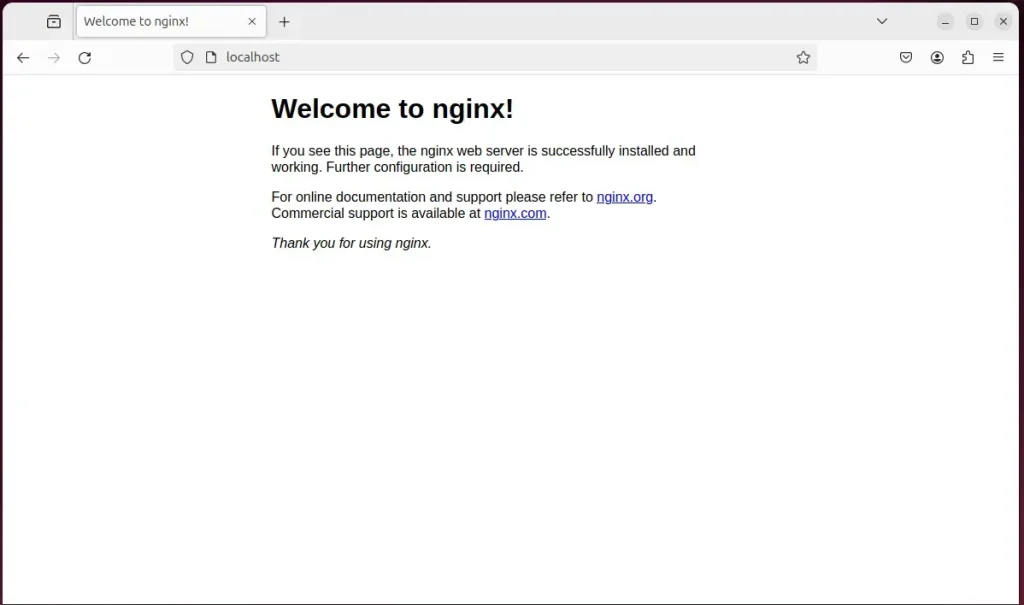
When you see the “Welcome to nginx!” it means the Nginx HTTP server is successfully installed.
Additional help on installing Nginx on Ubuntu is in the link below.
How to install Nginx on Ubuntu
Install MariaDB database server on Ubuntu Linux
The next component that is required to run Moodle is a database server. This post will install and use the MariaDB database server to run Moodle.
To install and use the MariaDB database server, use the instructions below.
Open the Ubuntu terminal and run the commands below to install the MariaDB database server.
sudo apt update sudo apt install mariadb-server
Once the MariaDB database server is installed, use the commands below to stop, start, and enable the MariaDB server to start automatically when the server boots.
sudo systemctl stop mariadb sudo systemctl start mariadb sudo systemctl enable mariadb
Run the following commands to validate and test if the MariaDB database server is installed successfully.
sudo mariadb
Once you run the commands above, it will log you onto the MariaDB console and display a message similar to the one below.
Welcome to the MariaDB monitor. Commands end with ; or \g. Your MariaDB connection id is 32 Server version: 10.11.2-MariaDB-1 Ubuntu 23.04 Copyright (c) 2000, 2018, Oracle, MariaDB Corporation Ab and others. Type 'help;' or '\h' for help. Type '\c' to clear the current input statement. MariaDB [(none)]>
The message tells you that the server is installed successfully.
Additional help on installing MariaDB.
Create a Moodle database
Upon successfully installing the MariaDB database server, create a blank database specifically for the Moodle application on the server.
As part of the setup, we will create a database named ‘moodledb ‘and a corresponding user account named ‘moodledbuser ‘.
Finally, we’ll grant the moodledbuser full access to the moodledb database.
All the database steps above can be done using the commands below:
But first, log on to the MariaDB database server:
sudo mariadb
Then run the commands below to complete the steps:
CREATE DATABASE moodledb CHARACTER SET utf8mb4 COLLATE utf8mb4_general_ci;
CREATE USER moodledbuser@localhost IDENTIFIED BY 'type_your_password_here';
GRANT ALL ON moodledb.* TO moodledbuser@localhost WITH GRANT OPTION;
FLUSH PRIVILEGES;
exit
Ensure to replace ‘type_your_password_here‘ with your password.
Install PHP-FPM on Ubuntu Linux
The last component you will need to run Moodle is PHP-FPM. The Moodle application is PHP-based and supports the latest versions of PHP-FPM.
Run the commands below to install PHP.
sudo apt install php-fpm php-intl php-mysql php-curl php-cli php-zip php-xml php-gd php-common php-mbstring php-xmlrpc php-json php-sqlite3 php-soap php-zip
Additional help on installing PHP
How to install PHP on Ubuntu Linux
Download Moodle files
Let’s begin the straightforward downloading and configuring the Moodle files on Ubuntu Linux. Run the commands below to download and extract the Moodle files to the Nginx web server root directory.
The command block below will download and create a new Moodle folder in the Nginx root directory.
First, create a Moodle folder in the Nginx root directory.
Next, navigate to the /tmp directory and download Moodle files. After unzipping the file, move the content into the Moodle folder you created in the Nginx root directory.
Rest assured, the final step is to change the permissions. This will allow the Nginx web server to safely interact with the files, ensuring a secure environment for your Moodle installation.
Stay up-to-date with Moodle’s latest version. Get it from the official download page and replace the link with the new version to ensure you benefit from the latest features and security updates.
cd /tmp/
wget https://download.moodle.org/download.php/direct/stable404/moodle-4.4.zip
sudo unzip -d /var/www moodle-*.zip
sudo mkdir -p /var/www/moodledata
sudo chown -R www-data:www-data /var/www/moodledata/
sudo chown -R www-data:www-data /var/www/moodle/
Once you have completed all the above steps, continue below to configure the Nginx web server to serve the Moodle content.
Run the commands below to create a Nginx virtual host file for Moodle.
sudo nano /etc/nginx/sites-available/moodle.conf
Then, copy and paste the content block below into the Nginx server block.
server {
listen 80;
listen [::]:80;
root /var/www/moodle;
index index.php;
server_name moodle.example.com www.moodle.example.com;
location / {
try_files $uri $uri/ =404;
}
location /dataroot/ {
internal;
alias /var/www/moodledata/;
}
location ~ [^/].php(/|$) {
include snippets/fastcgi-php.conf;
fastcgi_pass unix:/run/php/php8.3-fpm.sock;
fastcgi_param SCRIPT_FILENAME $document_root$fastcgi_script_name;
include fastcgi_params;
}
}
Save the file.
Then, run the commands below to enable the server block and restart the Nginx server.
sudo ln -s /etc/nginx/sites-available/moodle.conf /etc/nginx/sites-enabled/
sudo systemctl restart nginx.service
Setup Let’s Encrypt SSL/TLS for Moodle
You may want to install an SSL/TLS certificate to secure your Moodle site. Secure your Moodle installation with HTTPS from Let’s Encrypt.
Please read the post below for additional resources on installing and creating Let’s Encrypt SSL certificates for Nginx.
How to set up Let’s Encrypt SSL certificate for Nginx on Ubuntu Linux
Once you have restarted the Nginx web server, open your browser and browse to the server hostname or IP address defined in the Nginx server block.
http://moodle.example.com
A Moodle installation wizard page should appear. Select the installation language and continue to the next page.
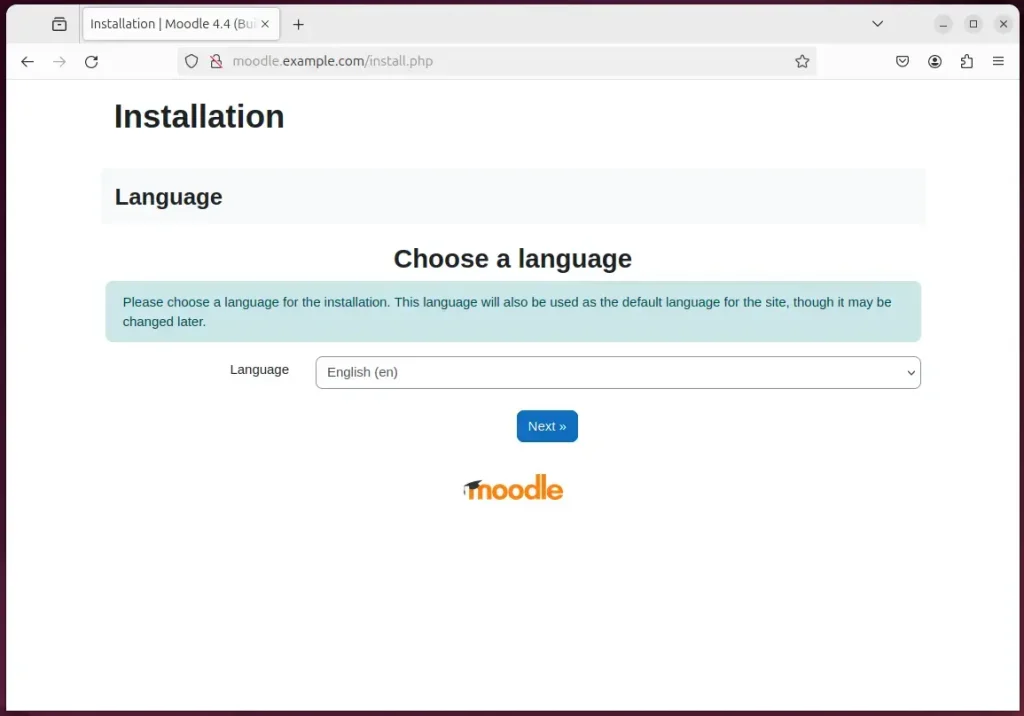
Confirm the installation paths and continue.
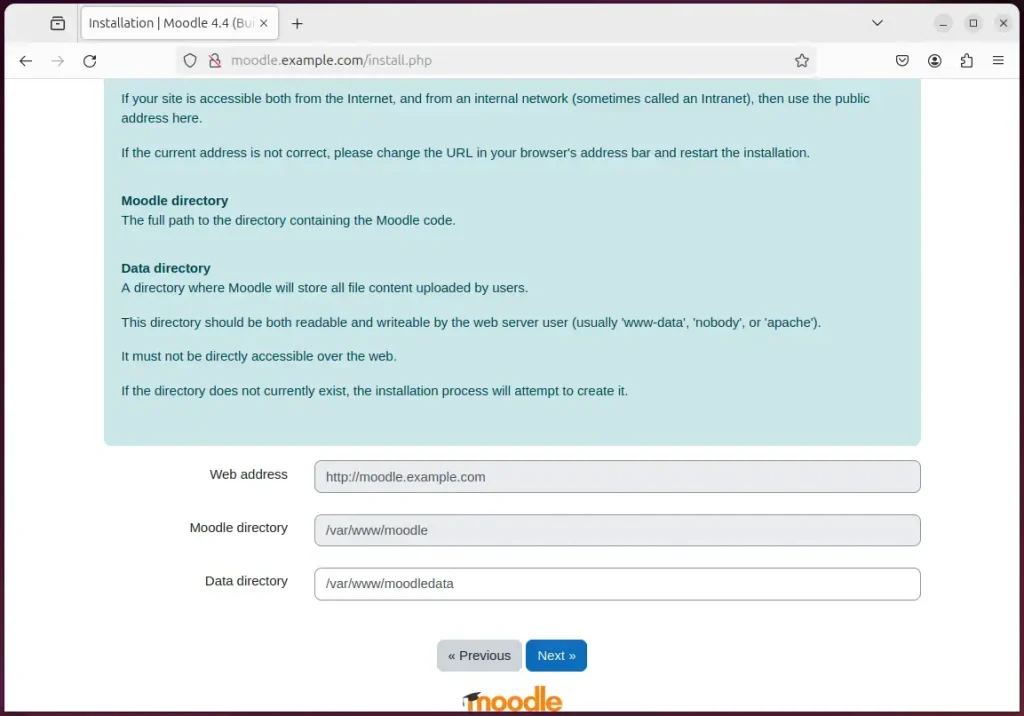
Next, choose a database driver (MariaDB) and continue.
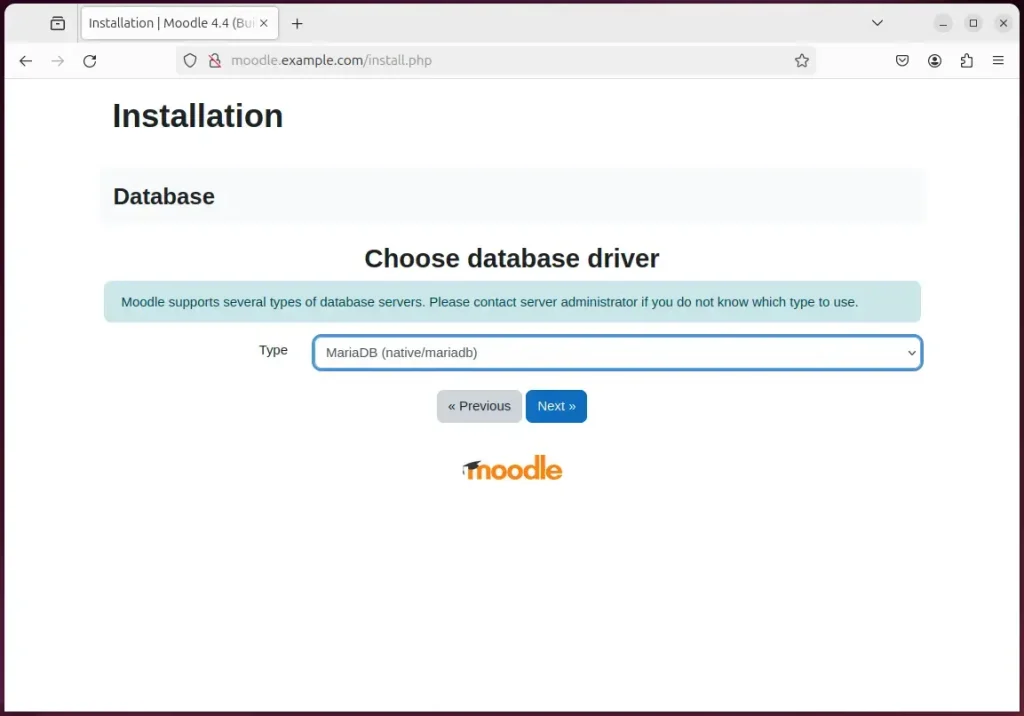
On the next page, type in the database name, username and password created above and continue.
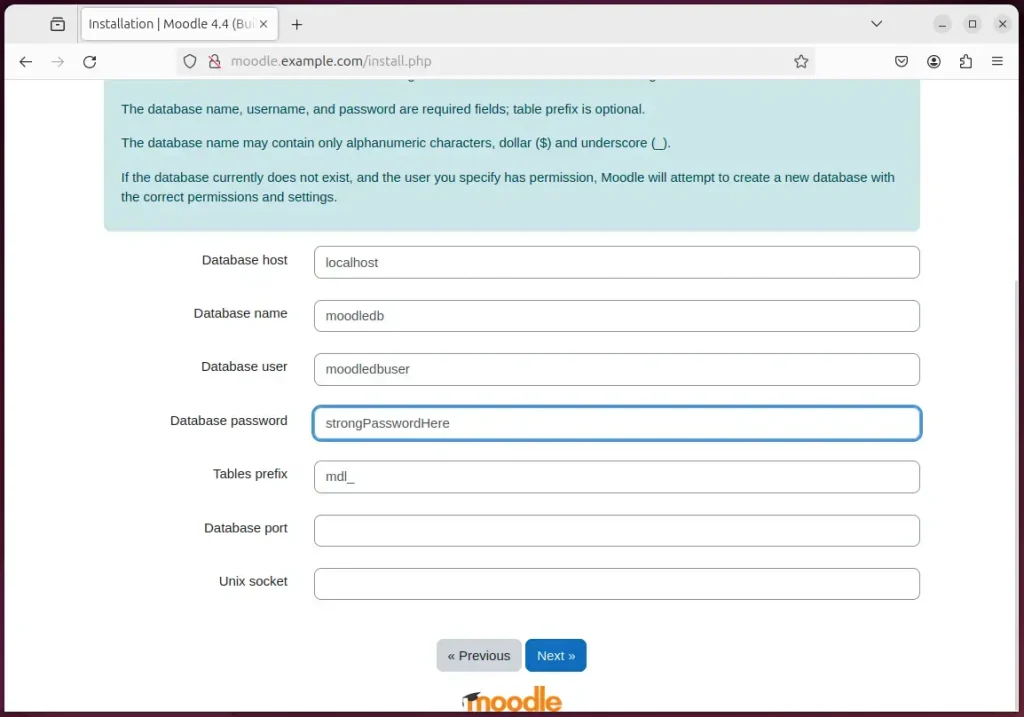
Confirm all requirements are met and continue.
If you get an error message that “max_input_vars” must be at least 5000, run the command below to fix it. Ensure that it is applied to the correct PHP version installed.
sudo sed -i "s/;max_input_vars = .*/max_input_vars = 5000/" /etc/php/8.3/fpm/php.ini
sudo systemctl reload php8.3-fpm

Next, set up your admin account and continue.
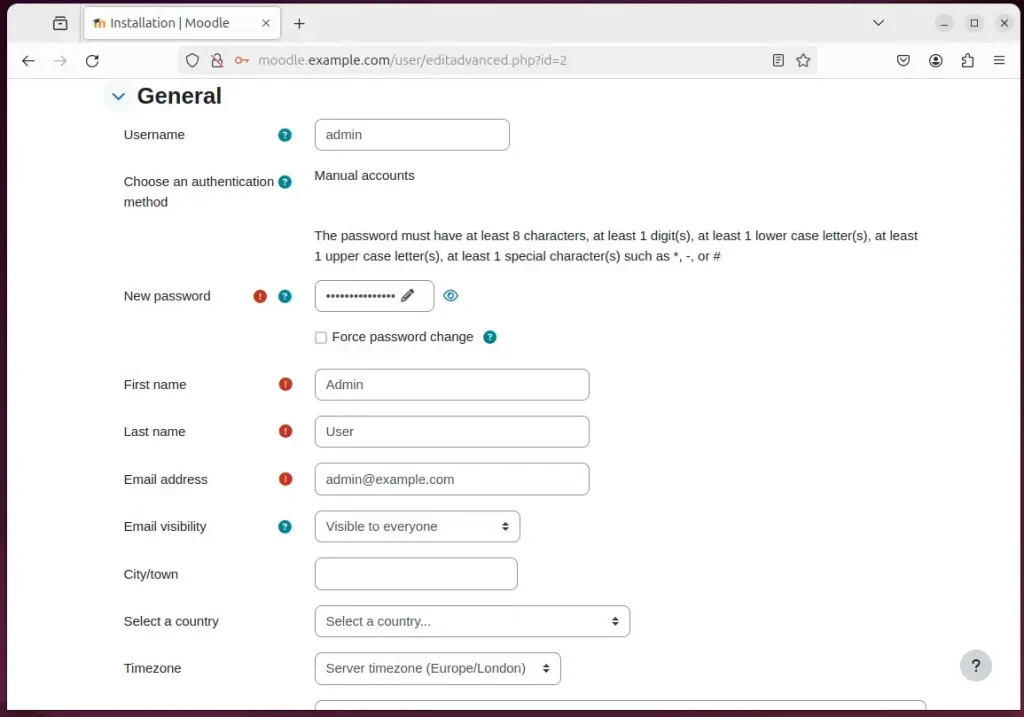
Your Moodle site should be set up and ready to use.

That should do it!
Conclusion:
- As this guide outlines, setting up a Moodle site with Nginx support on Ubuntu 24.04 can significantly enhance performance and scalability, making it an ideal choice for educational institutions.
- Leveraging Nginx’s low memory usage and high concurrency, combined with the powerful MariaDB database and PHP-FPM, ensures a highly responsive user experience for Moodle.
- Step-by-step instructions encompass the installation of Nginx, MariaDB, and PHP-FPM, followed by the seamless downloading and configuration of Moodle files.
- Let’s Encrypt SSL/TLS implementation for Moodle further strengthens security and data protection, culminating in a fully operational Moodle site ready for use.
- Continuous updates and improvements from the Moodle community ensure that users can benefit from the latest features and security enhancements.

Leave a Reply